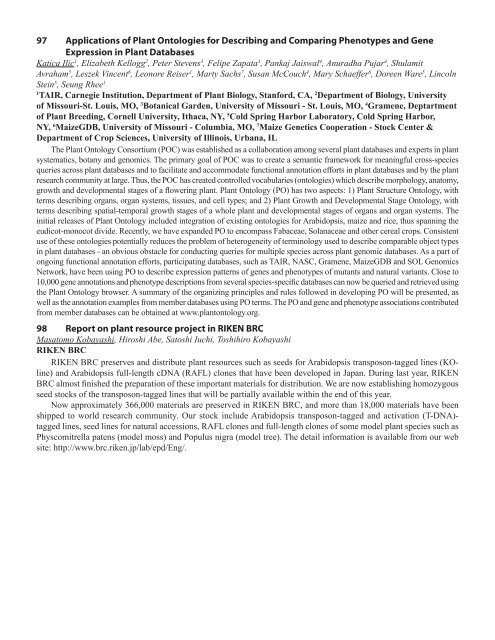75 Integrating Membrane Transport with Male Gametophyte ... - TAIR
75 Integrating Membrane Transport with Male Gametophyte ... - TAIR
75 Integrating Membrane Transport with Male Gametophyte ... - TAIR
You also want an ePaper? Increase the reach of your titles
YUMPU automatically turns print PDFs into web optimized ePapers that Google loves.
97 Applications of Plant Ontologies for Describing and Comparing Phenotypes and Gene<br />
Expression in Plant Databases<br />
Katica Ilic 1 , Elizabeth Kellogg 2 , Peter Stevens 3 , Felipe Zapata 3 , Pankaj Jaiswal 4 , Anuradha Pujar 4 , Shulamit<br />
Avraham 5 , Leszek Vincent 6 , Leonore Reiser 1 , Marty Sachs 7 , Susan McCouch 4 , Mary Schaeffer 6 , Doreen Ware 5 , Lincoln<br />
Stein 5 , Seung Rhee 1<br />
1<br />
<strong>TAIR</strong>, Carnegie Institution, Department of Plant Biology, Stanford, CA, 2 Department of Biology, University<br />
of Missouri-St. Louis, MO, 3 Botanical Garden, University of Missouri - St. Louis, MO, 4 Gramene, Deptartment<br />
of Plant Breeding, Cornell University, Ithaca, NY, 5 Cold Spring Harbor Laboratory, Cold Spring Harbor,<br />
NY, 6 MaizeGDB, University of Missouri - Columbia, MO, 7 Maize Genetics Cooperation - Stock Center &<br />
Department of Crop Sciences, University of Illinois, Urbana, IL<br />
The Plant Ontology Consortium (POC) was established as a collaboration among several plant databases and experts in plant<br />
systematics, botany and genomics. The primary goal of POC was to create a semantic framework for meaningful cross-species<br />
queries across plant databases and to facilitate and accommodate functional annotation efforts in plant databases and by the plant<br />
research community at large. Thus, the POC has created controlled vocabularies (ontologies) which describe morphology, anatomy,<br />
growth and developmental stages of a flowering plant. Plant Ontology (PO) has two aspects: 1) Plant Structure Ontology, <strong>with</strong><br />
terms describing organs, organ systems, tissues, and cell types; and 2) Plant Growth and Developmental Stage Ontology, <strong>with</strong><br />
terms describing spatial-temporal growth stages of a whole plant and developmental stages of organs and organ systems. The<br />
initial releases of Plant Ontology included integration of existing ontologies for Arabidopsis, maize and rice, thus spanning the<br />
eudicot-monocot divide. Recently, we have expanded PO to encompass Fabaceae, Solanaceae and other cereal crops. Consistent<br />
use of these ontologies potentially reduces the problem of heterogeneity of terminology used to describe comparable object types<br />
in plant databases - an obvious obstacle for conducting queries for multiple species across plant genomic databases. As a part of<br />
ongoing functional annotation efforts, participating databases, such as <strong>TAIR</strong>, NASC, Gramene, MaizeGDB and SOL Genomics<br />
Network, have been using PO to describe expression patterns of genes and phenotypes of mutants and natural variants. Close to<br />
10,000 gene annotations and phenotype descriptions from several species-specific databases can now be queried and retrieved using<br />
the Plant Ontology browser. A summary of the organizing principles and rules followed in developing PO will be presented, as<br />
well as the annotation examples from member databases using PO terms. The PO and gene and phenotype associations contributed<br />
from member databases can be obtained at www.plantontology.org.<br />
98 Report on plant resource project in RIKEN BRC<br />
Masatomo Kobayashi, Hiroshi Abe, Satoshi Iuchi, Toshihiro Kobayashi<br />
RIKEN BRC<br />
RIKEN BRC preserves and distribute plant resources such as seeds for Arabidopsis transposon-tagged lines (KOline)<br />
and Arabidopsis full-length cDNA (RAFL) clones that have been developed in Japan. During last year, RIKEN<br />
BRC almost finished the preparation of these important materials for distribution. We are now establishing homozygous<br />
seed stocks of the transposon-tagged lines that will be partially available <strong>with</strong>in the end of this year.<br />
Now approximately 366,000 materials are preserved in RIKEN BRC, and more than 18,000 materials have been<br />
shipped to world research community. Our stock include Arabidopsis transposon-tagged and activation (T-DNA)-<br />
tagged lines, seed lines for natural accessions, RAFL clones and full-length clones of some model plant species such as<br />
Physcomitrella patens (model moss) and Populus nigra (model tree). The detail information is available from our web<br />
site: http://www.brc.riken.jp/lab/epd/Eng/.





